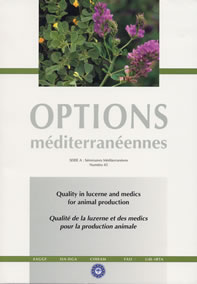| Article précédent | p. 257-260 | Article suivant |
Compounds and genes for enhanced protein assimilation and digestibility in forage legumes: Altering condensed tannins content in the leaves of forage legumes
The aim of the European Union CAGED project is to elucidate the biosynthetic pathway of CT synthesis by isolating and functionally assessing key genes from the CT pathway. This knowledge will guide our assessment of the options for modifying commercially grown forage legumes to express desirable levels of CT by use of modern breeding methodologies, gene-targeting and mutation. Central to our strategies is the CT accumulating species Lotus corniculatus. This model crop is a bone fide forage legume that is polymorphic for CT and is well adapted to in vitro manipulation and genetic transformation. We at IGER are collaborating with our colleagues at IRMGPF to isolate CT genes from L. corniculatus, characterising their regulation and evaluating their precise role in CT synthesis. In addition, we are closely involved with the Genetics and Breeding of Forage Legumes Group at INRA, who have extensive experience of forage digestibility and protein degradation analysis.
- [ Afficher ]
- [ Télécharger ]
- [ Exporter la citation ]
Vous pouvez télécharger la citation au format :
- [ Imprimer ]
-
Mots-clés
FOURRAGE, LEGUMINEUSE, LOTUS CORNICULATUS, PROTEINE, QUALITECiter cet article
Allison G., Hughes J.W., Morris P., Robbins M.P. Compounds and genes for enhanced protein assimilation and digestibility in forage legumes: Altering condensed tannins content in the leaves of forage legumes. In : Delgado I. (ed.), Lloveras J. (ed.). Quality in lucerne and medics for animal production . Zaragoza : CIHEAM, 2001. p. 257-260. (Options Méditerranéennes : Série A. Séminaires Méditerranéens; n. 45). 14. Réunion Eucarpia du Groupe Medicago spp., 2001/09/12-15, Zaragoza and Lleida (Spain). http://om.ciheam.org/om/pdf/a45/01600095.pdf



